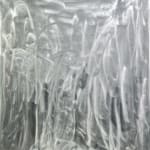

Leander Herzog
In "Credit Suisse," Herzog interrogates contemporary anxieties around artistic agency through a radical gesture of self-erasure, whereby found aluminium advertising boards are recontextualised as autonomous artworks. These industrial artefacts, bearing the accumulated marks of commercial display, function simultaneously as both medium and metaphor, their polished surfaces recording an archaeology of anonymous labor.
The work's material presence - crystalline post-adhesive scratches operate as a critical meditation on authenticity in an era of algorithmic reproduction. Herzog, known for his work in generative art, here deliberately absents himself from the creative process, allowing the quotidian actions of urban workers to generate abstract compositions that no algorithm could authentically replicate.
Is Herzog's self-erasure from the creative process a surrender to the zeitgeist, or a defiant last gesture?
Through this recontextualisation, Herzog establishes a dialogue between individual artistic gesture and collective labor, marking a space where the boundaries between creator and created begin to dissolve. Rather than employing algorithms to generate artwork, he elevates the incidental traces of human activity to the status of fine art, creating a dialectic between intentional and unconscious mark-making. The accumulation of marks and scratches becomes a poetic register of urban existence, documenting countless anonymous interactions throughout the object's commercial life.
"Credit Suisse" deals with the erosion of artistic autonomy in an increasingly automated world. It suggests, perhaps, that authentic human presence persists precisely in those spaces where we cease to consciously perform it, and that the possibility of meaningful artistic intervention lies in recognising and elevating these traces of unconscious creativity.



